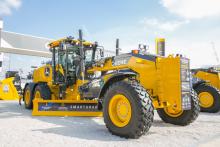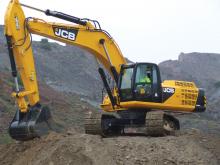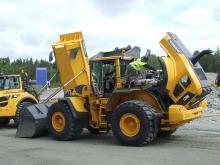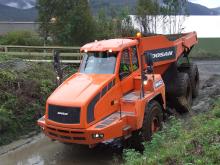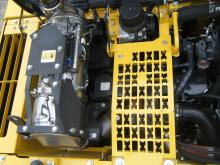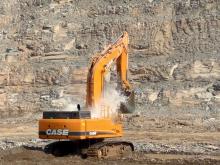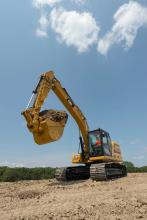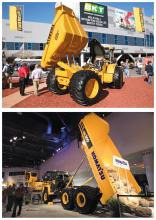
Competition is increasing in the earthmoving sectors, and for some companies market share is improving
The wheeled loader market is becoming more competitive, with a number of firms now challenging the leading players,Case is gearing up its operations in Western Europe, Eastern Europe, Russia, the Middle East and Africa. The firm recently held a major event at the Alfa Romeo Balocco facility owned by the parent
Several key product introductions have been made, such as the 1221E wheeled loader. With this machine the company hopes to build a share of the quarrying sector, as it already offers an 80tonne class excavator as well as 36tonne and 30tonne payload ADTs. This all-new heavy line is an important addition to the Case range and takes the firm into competition at the larger end of the equipment line with other major manufacturers, and most particularly Caterpillar, Komatsu and Volvo. The 30tonne class Case 1221E is powered by a six cylinder,
For the excavator market Case is now offering its high performing CX350B model, with power from a six cylinder, 205kW
Case also has an array of new dealers added across Western Europe, Eastern Europe, Russia, the Middle East and Africa. The company says it scored significant gains in market share in territories such as Turkey and the fast-growing Russian construction sector. Interestingly, the 330B and 340B ADTs are now starting to be supplied into Turkey and Tunisia. This last is an important step for Case as the company is developing its presence in Turkey and Tunisia while the machines are comparatively new to these countries and offer additional potential.
With Doosan Infracore's improved wheeled loaders now coming to market, the firm is offering a seven model line-up. The new DL450 strengthens the firm's heavier loader range and suits duties in applications such as large earthmoving duties, quarrying, materials handling and recycling. The 25.5tonne DL450 slots into the range between the existing DL400 and the DL500.
Power for the machine comes from a six cylinder, 11litre Cummins QSM11 diesel delivering 227kW and for customers with large machine fleets spares holdings will be reduced as the engine is the same unit as used on the existing 30.7tonne DL500. The engine drives through a ZF gearbox and axles, with limited slip differentials to improve traction and minimise tyre wear. The machine also features a torque converter stator with a free wheel system that helps reduce fuel consumption in load and carry duties. Load sensing steering is fitted, while a variable-delivery, hydraulic piston pump further helps reduce fuel consumption. A variable-speed fan is fitted, which helps cut working noise and fuel consumption and this fan can rotate in either direction for automatic radiator cleaning. Maintenance tasks are further improved as the machine can be connected to a laptop to identify service requirements or problems.
Hyundai Heavy Industries is in a strong position at the moment, with its operations performing well worldwide and the firm also having just made its 150,000th excavator. The company continues to develop its wheeled loader range and has been particularly successful in Eastern Europe with these machines. The current top-of-the-line HL780-7 has pushed the firm into a larger loader category than before. Interestingly, the firm is also planning to build a line of wheeled loaders in China that will be built in a new plant and aimed specifically at the local market. The company intends to develop the product line too and says is also developing ADT models, which will be complimentary to the wheeled loader and excavator ranges. Hyundai is already supplying its 50tonne heavy duty excavator worldwide and the firm's top-of-the-range 70tonne excavator is now out of the prototype and test stage, with orders now in the pipeline.
And although JCB's 50tonne class JS520 excavator has yet to finish its development, the machine will push the company into a higher product category.
Also in the excavator sector, Volvo is also developing its presence as the company intends to rank amongst the worldwide market leaders. The firm has made particular strides in the heavyweight excavator classes with the latest EC460CL and EC700CL models said to offer a combination of productivity, fuel efficiency and reliability.
The EC460CL is aimed at bulk excavation operations, weighs from 45.6-48.3tonnes depending on specification, while the additional variable undercarriage option increases maximum weight to 51tonnes. Meanwhile the EC700CL can also be used in mass excavation and loading duties and like the smaller machine, is said to be able to compete with larger excavators from other manufacturers in terms of performance. Both excavators are equipped with low emission engines featuring the firm's V-ACT technology, with output ratings of 235kW and 316kW respectively.
Using the firm's MATRIS system, customers can analyse machine utilisation and efficiency, helping to cut overall maintenance costs and boost service life. When fitted with the optional CareTrack GPS monitoring system, machine location can be tracked remotely while the client can access the onboard diagnostic system and monitor fuel usage, hours of operation and productivity
Productivity boost with PowerDigger package
The system gives the operator real-time information on depth, slope and reach on an easy-to-read graphical control panel mounted in the cab. An LED light-bar shows the operator how far the machine has dug, aided by an audible tone that gives an additional on-grade or near-grade indication.
The sensors for the PowerDigger excavator system are of the gravitational reference type and are said to be highly responsive and accurate. These units are also waterproof to at least 20m and are durable enough to cope with a hydraulic hammer being used on the carrier machine. Sophisticated CANbus accelerometers are also used to measure the position of the boom, stick and bucket, while the sensors come with special mountings to speed installation.
Adding on an MRS300 Sensor upgrades the system to dual grade status and will compensate for machine, pitch, roll and rotation, while a tilt bucket sensor can also be added. The firm says that the package can also be upgraded to 3D capabilities by adding the PowerDigger 3D computer.
The company also says that its innovative PowerGrade system can be moved quickly from one machine to another. Machine settings are stored within the unit, which gives automatic control of slope and elevation and due to its rugged design, can be used in tough construction duties. The system gives automatic control of both slope and elevation, while installing an additional mast and laser sensor allows work to be carried out independently of the slope direction. The system is ideal for contractors who want to further increase machine productivity while working with an easy-to-use, high accuracy grade control. The Leica PowerGrade system is easily upgraded from basic 2D to 3D capabilities and can be installed quickly on the machine along with the necessary software.

